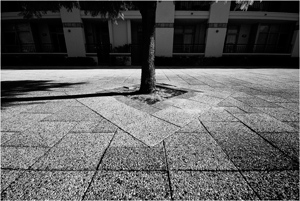Spot-on exposure with Aperture Priority
For many of us DSLR users, shooting in Aperture Priority is the first port-of-call from shooting with the Automatic or Scene Exposure modes on our camera. It often occurs after we’ve come to grips with depth of field and after we’ve conquered the initial confusion over the inverse rule of “small f-number equals big aperture”.
Shooting in Aperture Priority is a powerful approach to taking photographs – by adjusting the Aperture, you can control the zone of sharpness in the picture: a shallow depth of field creates beautiful portraits by separating the subject from the background; a deep depth of field is ideal for landscapes or street photography, where you require sharpness in subjects at varying depths within the frame. Simply set the Aperture and the camera decides the best shutter speed for the exposure.
Remember that depth of field is also controlled by subject to lens distance, and also by the focal length you’re using. The closer the lens is to the subject and the longer the focal length, the shallower the depth of field.
However, Aperture Priority has its own challenges. Because you’re letting the camera automatically determine “best exposure”, the exposure meter on your DSLR can be tricked if the overall scene is too bright or too dark, leaving you with under- or over-exposed shots.
To counter this, you need to understand how your camera interprets what it “sees” of the world.
Your DSLR sees the world as a range of grey tones that range from black to white, and it wants to average the tones out to obtain a boring, middle grey. If there are strong shadows in the picture, it will lift the exposure in the shadows, brightening them so that it can see detail in the shadows. If there are very bright areas in the frame, it will do the reverse, deliberately darkening the brightness so that the average tone conforms to that dull middle grey.
If you were to convert a photograph taken with a DSLR into black and white, and then average the tones, you’ll arrive at middle grey. Behold! Middle grey:

A digital black and white image

Average out the tones and you get: middle grey!
Take note of that shade of grey (insipid isn’t it?) – commit it to memory as it will prove valuable in your photography. Or, if your memory isn’t too reliable, you can also purchase middle grey as a card from your local photography store (around AUD$20-$25).
However, things in this world are rarely middle grey. Look around you. Are there objects or surfaces around you that match this middle grey in their tonality (you’ll need to convert the object to black and white with your imagination)? Most objects are usually darker or brighter than middle grey – sometimes by a lot, sometimes by a little. Consider a limestone wall, concrete pavement, timber, skin, clothing, curtains and so on.
If you’re photographing someone standing against a dark timber wall, the overall darkness of the background may confuse your DSLR’s exposure meter, causing it to over-expose the scene. Great if you want to be able to see the wood grain detail of the wall; bad if you’d like to retain the correct exposure of your subject’s skin tone!
To correct this, you need to train your eye to judge how much brighter or darker an object or surface is from middle grey. A limestone wall may be twice brighter; a dark curtain may be twice darker; deep shadows can be three times or more darker.
Once you’re able to ascertain this, you can easily compensate for this using the Exposure Compensation function on your DSLR.
Exposure Compensation What?
Exposure compensation lets you over-ride the exposure determined by the camera’s meter with a predetermined value to over- or under-expose the scene. Exposure can be adjusted across intervals of +/- 3 (or +/- 2 on some DSLRs). To locate the Exposure Compensation function, look for the button on the back/top of your DSLR that shows a +/- symbol.
Each +/- 1 that you dial into Exposure Compensation is called a Stop, and equates to affecting the exposure by a factor of two. If you dial +1 exposure compensation, then you’re effectively doubling the exposure (overall brightness) of the scene. If you dial -1 exposure compensation, you’re effectively halving the exposure.
Boffin note: Many DSLRs let you adjust Exposure Compensation by 1/3 of a stop each way. Hence, you can go +/-0.3, +/-0.7, +1, +/-1.3 and so on.
Given that you’re now able to judge how much brighter or darker an object is from middle grey, you should be able to compensate for this using Exposure Compensation.
For instance, if the timber wall was twice darker than middle grey, simply dial your compensation down to -1. Conversely, if the limestone wall that forms the backdrop of your scene is twice brighter than middle grey, dial your compensation to +1. Take the shot – and she’ll be apples.
Almost!
Combining Exposure Compensation with Spot Metering can give you a more accurate exposure.
Spot Metering
Spot metering is one of three or four exposure metering modes available on most DSLRs. Unlike the other metering modes, spot metering detects the exposure from one spot in the frame – whatever it is that the little dot in the middle of your viewfinder is pointing at; it ignores everything else. Point the spot at someone’s black t-shirt and the camera will think that the entire scene is black (and behave accordingly).
In the example above, spot metering off the timber wall will make the camera expose for that wall. If the wall is too dark, it will want to brighten the scene to make the average tone middle grey. By dialing in the -1 exposure compensation, you’re ensuring that the wall remains appropriately dark. It’s a conversation that goes something like this:
Camera: Yikes! That wall is too dark. I must brighten the image so that it becomes middle grey — my favourite tone of all time.
You: No! No! If you do that, you’re going to over-expose the scene. The fair skin of my lovely partner sitting in front of the wall will become even paler!
Camera: Sorry, mate. I gotta do what I gotta do.
You: We’ll see about that. You go on and brighten the image like you want to. I’ll dial in a -1 exposure compensation to bring your tones back to what is correct, which is what I see with my human eyes.
Finally, combining this new skill with your DSLR’s Auto-Exposure Lock function will let you nail the exposure each time.
Auto Exposure Lock
Auto Exposure Lock (AEL) lets your lock the exposure value so that even if you were to point your camera at a differently lit scene, the exposure values would remain unchanged. The Auto Exposure Lock is triggered with a button on your camera.
Canon users – look for the star or asterisk symbol on or under a button. Nikon users – look for the AEL sign on a button (check your manual to see if you need to assign this function to that button – which may be the case for Nikon D200, D300 and D700 users).
Once you have used spot metering and exposure compensation to obtain correct exposure, simply press the AEL button to lock exposure, grab your focus, recompose and take the shot! You’ll have a properly exposed photograph, obtained while shooting in Aperture Priority.
Middle Grey and the Real World
So how far off middle grey are the tonal values of objects and surfaces in the real world? Use this as a guide:
- Dark stone, dark foliage, timber, shadows in a landscape: -1 Exposure Compensation
- Dark skin (darker than olive skin), weathered wood, grass, clear southern sky: 0 (it’s middle grey!)
- Very fair skin (Caucasian skin), sand on the beach: +1 Exposure Compensation
If you’re photographing a fair-skinned person, simply set your Exposure Compensation to +1, spot meter off their skin, trigger AEL and take the shot. Regardless of whether the person is standing against a dark or bright background, you’ll obtain correct exposure for them.
Here is Amy, one of our models from the Practical Portraiture workshop, standing against a limestone wall of a local church. The bright wall, coupled with her dark top would normally confuse the camera’s exposure meter. Spot metering off her skin, with a +1 Exposure Compensation lets you ensure that her skin will be properly exposed in this frame.

Aperture Priority vs Manual Exposure
Those of you comfortable with shooting in Manual Exposure will realise that you can manually dial in exposure compensation and create the same outcome as the above. It’s the manual dialing in the compensation that is the difference.
If you’re shooting on the fly, under lighting conditions that change rapidly, and where your ability to capture the moment is critical (think weddings, or kids!), you can lose precious seconds adjusting the exposure manually. Shooting Aperture Priority with exposure compensation, spot metering and AEL in combination, it’s a case of knowing what you’re going to use as your exposure surface (eg. the subject’s skin), dialing in the appropriate Exposure Compensation, spot metering, locking exposure, and then snapping away.
Practice it and you’ll find that it quickly becomes quite instinctive, freeing you to devote more of your attention to nailing that shot!

Jim Pool
18/08/2010 at 7:41 pmGreat article on AV priority vs. Manual.Ihave been going crazy tring to understand when to use on or the other. Thank you.
Peter Marin
03/06/2011 at 10:30 pmVery well explained. People have a lot of trouble comprehending the ‘middle gray’ component of metering. I think you did a good job here of simplifying it. I shoot manual 90%, and AV the rest of the time, I love the consistency it brings across the shoot.
sengmah
06/06/2011 at 9:27 pmThanks for the comment, Peter. Understanding “middle grey” is a very powerful tool in understanding how one can use exposure creatively, and something I try and instil in my workshop participants.
brian t
23/08/2015 at 3:42 amGreat article.